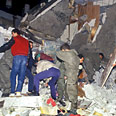
Assad's arsenal
Syrian military has chemical weapons but won’t be quick to use them
If the news items regarding the infiltration of IDF aircraft into northern Syria's airspace are true, then the concern expressed by Syria is clear.
The reports publicized recently about a significant military build-up in Syria pertained to Syria's desire to strengthen entire sections of its security apparatus, which has been neglected for many years.
The Gulf War in 1991 constituted a key development in Syria's approach towards Israel. A Syrian division joined American forces at the time. President Hafez Assad read the reports compiled by his people and was amazed by America’s technological capabilities.
"If this is what the Americans have – the Israelis have much more," he told his associates. In other words: Assad clearly understood his army's inferiority against the IDF and decided to join the Madrid conference and enter negotiations with Israel. Nonetheless, Syria continued to vigorously develop its Air Force and its ground-to-ground missiles whose range covers Israel's entire territory.
Simultaneously, the Syrians armed themselves with what is termed "the nuclear weapons of the poor" – ie chemical weapons. They view this as a strategic response to the nuclear weapons the world claims Israel has in its arsenal.
In December 1991, then IDF Chief of Staff Ehud Barak stated that Syria's chemical capability "is greater than that of Iraq." Two plants manufacturing chemical weapons are located in Allepo in northern Syria, and Scud missiles armed with chemical weapons are deployed in al-Safir in the south.
Syria's chemical weapons plants are relatively small, and therefore difficult to detect. In addition to dedicated factories, Syria can also take advantage of the potential of more than 12 government pharmaceutical plants that can quickly be transformed to manufacture chemical warfare materials.
The Yom Kippur War proved to the Syrians that even when they launch a successful surprise attack, their aircraft are still incapable of penetrating deep into Israel. The Israel Air Force's technological and human resource superiority coupled with advanced anti-aircraft systems foiled the attempts to bomb deep inside Israel. Syria reached the conclusion that it required an additional force.
Successful missile tests
Since 1995, and perhaps even prior to that, Syria has been serially manufacturing Scud C type missiles that are capable of reaching any point in Israel. The arsenal in the hands of the Syrians was extended at the end of 2000 by some 300 to 400 Scud B and C type missiles and 30 launchers. A Scud B missile is capable of carrying a 1,000 kilogram warhead to a distance of up to 300 kilometers (roughly 200 miles.) Scud C type missiles can carry a 770 kilogram warhead to a distance of up to 500 kilometers (roughly 320 miles.)
At the end of September 2000, Syria conducted several successful tests with Scud D missiles, which reached a range of 580 kilometers (roughly 360 miles) during these tests. At the beginning of July 2001, Israel monitored the launching of a Scud missile fired from the Haleb region in the north of Syria until it landed 700 kilometers (roughly 430 miles) from there in the southern desert.
Israel's assumption is that Syria knows all too well that Jerusalem will respond harshly to the use of chemical weapons against it. As in Saddam Hussein's case, Israel believes that Basher Assad will order the launching of missiles at us only if he feels his regime is at risk.










